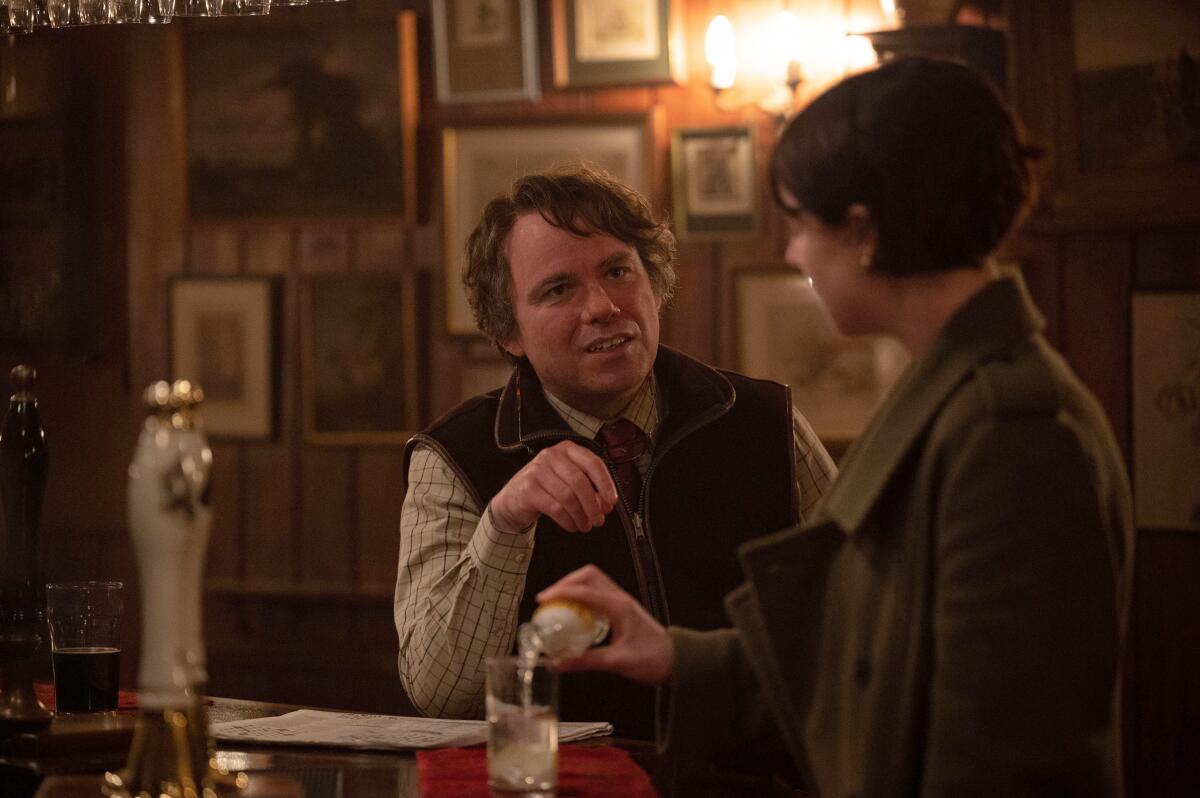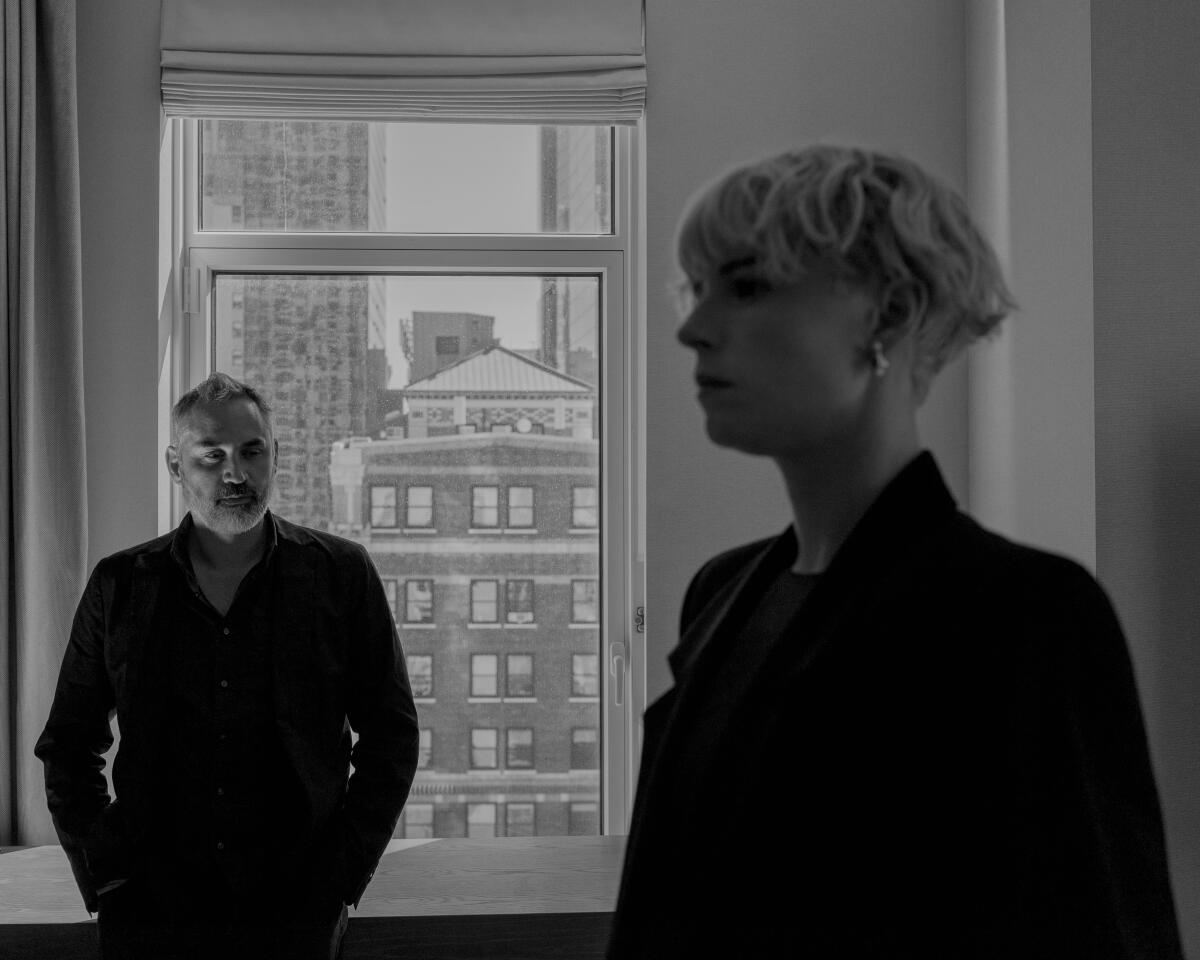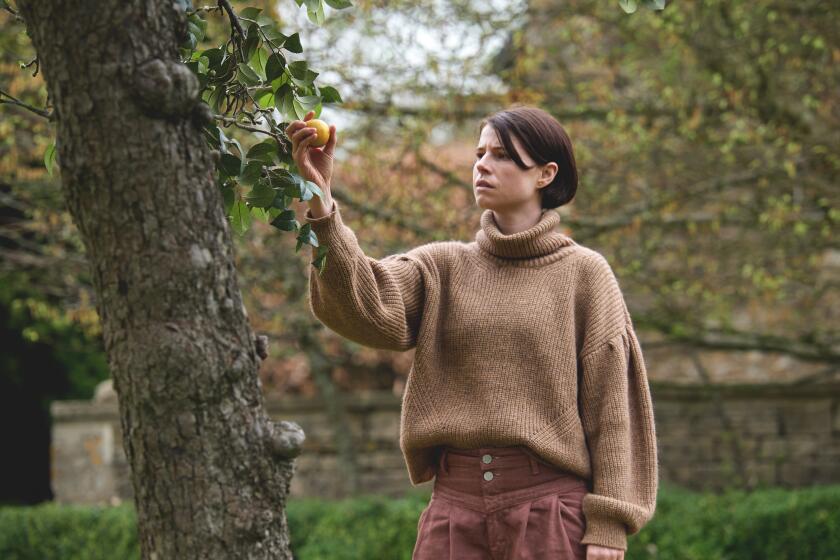Let’s talk about that ‘Men’ ending with the people who created it

Warning: This article contains major plot spoilers about “Men.” If you haven’t seen it yet, we suggest reading this review or this story about the making of the film, then come back.
If you just finished watching Alex Garland’s new folk-horror film “Men,” you might need a little time to process it. At least that’s what Garland hopes.
“Most people watch a film and they just kind of shrug and send an email or go get a beer or whatever,” the British writer-director says. “But if anyone is provoked by this film, hopefully they can query the provocation.”
On the surface, the story of “Men” seems as simple as its title: A woman named Harper (Jessie Buckley) retreats to the pastoral English countryside following the death of her estranged husband (Paapa Essiedu). There, she finds herself terrorized and manipulated by a series of men, including a naked stalker, a gaslighting vicar and a creepy local policeman — all of whom bear an uncanny resemblance to one another (they’re all played by actor Rory Kinnear).
Alex Garland and Jessie Buckley discuss their collaboration on the folk-horror film ‘Men,’ which has plenty of provocative things to say about relationships between men and women.
“There’s a fable quality to the film,” Buckley says. “It’s like a kind of fairy tale.”
But like Garland’s previous films, 2014’s “Ex Machina” and 2018’s “Annihilation,” “Men” has a lot on its mind: themes of misogyny and toxic masculinity, pagan symbols, literary allusions. The film is dense with references to everything from Ulysses to the Bible to Yeats to Agamemnon to the Green Man and sheela na gig, mysterious ancient carvings found on churches throughout Europe. “If anybody wanted to start unpacking it, they would find some interesting avenues,” Garland says.
Like many a final-girl horror film, from “Halloween” to “The Texas Chainsaw Massacre,” “Men” climaxes with Harper facing off against the monster who has been tormenting her. But this hallucinatory and surreal final confrontation is anything but typical, upending whatever genre expectations the audience may have going in.
In the film’s final sequence, Harper, having been thwarted in her attempt to escape from the cottage, finds herself menaced (or men–aced) by the various figures who have stalked and gaslit her throughout the film, each being birthed out of another in a graphic and stomach-churning orgy of David Cronenberg-style body horror.

This succession of grotesque births — with each successive incarnation bearing the same gruesome torn arm that Harper’s husband had after falling (or jumping) to his death — finally produces Harper’s husband. He sits beside her on a couch and, laying a final, manipulative guilt trip on her, tells her that all he ever really wanted was for her to love him.
“The monster’s big final moment has a lot of patheticness built into it,” Garland says. “If a guy is violent, he can have a weird mixture of something intimidating and pathetic. But there might also be something touching and just kind of honest in that moment as well.”
While Harper has been plagued by grief and guilt over her husband’s death — and is cruelly blamed for it by the vicar — the film deliberately leaves the question of whether he died accidentally or by suicide unresolved. Indeed, Garland says there is no real answer.
“It was quite important that Jessie’s character does not actually know what happened to him,” Garland says. “So because the character doesn’t have a definitive answer to that, I never had one.”
Jessie Buckley goes up against a multitasking Rory Kinnear in ‘Men,’ the latest mind-bender from the director of ‘Ex Machina’ and ‘Annihilation.’
In employing and twisting imagery of birth, Garland was both drawing upon the ancient fertility iconography of sheela na gigs — centuries-old carvings showing women displaying oversized genitalia — and exploring people’s discomfort with the process of childbirth itself.
“A lot of the imagery people respond to in that sequence actually should be very un-frightening,” Garland says. “There isn’t a single person on the planet who didn’t arrive either by vaginal birth or cesarean. But some of what people get freaked out [about in that sequence] has to do with that absolutely fundamental and basic imagery, not with a weird scene in a horror flick. And that’s odd.”
For Kinnear, shooting the final sequence was deeply unpleasant. “It was like a week and a half of night shoots, and you’re cold and covered in goo, so you knew you might as well commit to it wholeheartedly,” the actor says. “I wanted to make sure that every time a new character emerged, they had a new attitude and had a need for something from Harper. Each character was nonverbally vocalizing this primal need.”

Instead of running away screaming or attempting to kill her tormentor, Harper — like the viewer — finds herself strangely transfixed by the series of births. “Seeing a body morph like that, kind of half-human and half-monster — it’s like, what the hell is going on?” Buckley says. “It’s really fascinating. You want to turn away but you’re afraid that you’re going to miss something as well. She’s not in a state of horror, which I think is a kind of interesting thing at that point.”
In the film’s final scene, we see Harper sitting alone outside the cottage the next day, as her friend Riley, who is revealed to be pregnant, arrives to make sure she is OK. Having survived the traumatic ordeal, Harper gives her friend a small, knowing smile, as if to say, “Men — what are you going to do?”
“The most important things in the ending sequence, from my point of view, are not to do with what Harper is reacting to but with the way that she reacts,” Garland says. “So not the birth, not the question or the blame or anything posed by her partner, but Jessie’s performance as Harper. It’s less to do with the initial shock value and more to do with how the protagonist is behaving. Her fear level and what was going on internally was something we talked about a lot. The smile between Harper and Riley at the end — that, at least for me, is where more of the interest lies.”
Just before the end credits roll, the film’s title finally appears onscreen in what Garland intended as a kind of dark punch line.
“It’s possible that something can be funny and serious at the same time,” says Garland. “I think the usage of the title at the end of the film is a mixture between something which is grim and very serious but also kind of dumb and silly and irreverent. All of that felt neatly encapsulated in that word.”
So is the film truly arguing that all men, in their hearts, are equally capable of monstrous behavior toward women? Or is it merely exploring those fears as a kind of #MeToo-era provocation?
Ultimately, Garland says it’s up to the viewer to decide based on their own experiences and preconceptions.
“I’ve heard interpretations of this film from different people who are perfectly intelligent and reasonable that are wildly different by 180 degrees,” he says. “And that is not really a reflection on the film. It’s a reflection of them.”
More to Read
Only good movies
Get the Indie Focus newsletter, Mark Olsen's weekly guide to the world of cinema.
You may occasionally receive promotional content from the Los Angeles Times.













